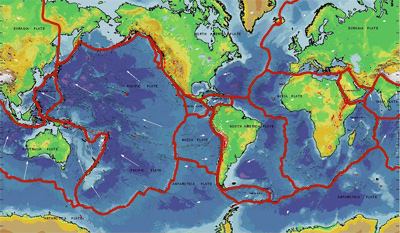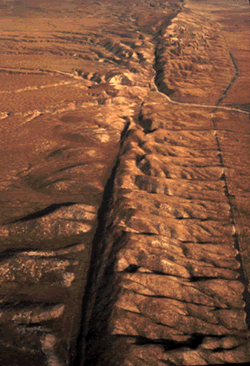The San Andreas fault in California is very distinct in the Carrizo Plain east of the city of San Luis Obispo, CA. Many faults can not be seen at the Earth's surface like this.
Click on image for full size
USGS
Why Do Earthquakes Happen?
When the giant blocks of rock that make up the Earth's crust are moved by plate tectonics, they are bound to bump into each other sometimes. These blocks of rock come in contact at faults. Sometimes they slide smoothly past each other. Other times the rocks get stuck - the rough surfaces of rock snag and they can't move along the fault. That might lead to an earthquake.
There might be no movement along a fault for a long time if the blocks of rock are hitched together. However, plate tectonic force continues to push the rocks so the energy builds up over decades, centuries, and sometimes even over millennia.
Eventually the energy is released as an earthquake when the force is large enough. The rock breaks, often very deep underground, and moves into a new position. Vibrations called seismic waves travel outward in all directions from the point where the energy was released. Like a stone tossed into a pond that sends concentric circles of ripples outward, the seismic waves radiate from the center of the earthquake. These seismic waves are what people on the surface of the Earth feel when they are in an earthquake.
There are different types of seismic waves. Some rumble the ground surface. Other types of seismic waves travel through the planet.
You might also be interested in:

The main force that shapes our planet's surface over long amounts of time is the movement of Earth's outer layer by the process of plate tectonics. This picture shows how the rigid outer layer of the Earth,
...more
The expression "on solid ground" is often used to describe something as stable. Usually the solid ground underfoot seems very stable. But sometimes it is not. "The ground seemed to twist under us like
...more
During an earthquake, energy is released in seismic waves that travel from where the earthquake starts, a place called the focus. The seismic waves radiate from the focus. Seismic waves cause intense shaking
...more
At 5:12 am on Wednesday April 18, 1906 most people in San Francisco, CA were still asleep. But they were about to wake up very suddenly. The Earth shook violently - an earthquake. It lasted for only about
...more
Plates at our planet’s surface move because of the intense heat in the Earth’s core that causes molten rock in the mantle layer to move. It moves in a pattern called a convection cell that forms when
...more
Spotting minerals is fun! There are many different types of minerals, each with a different name and a special set of characteristics. So, if you find a mineral that you do not recognize, you can use
...more
Quartz is one of the most common mineral in Earth’s crust! Silica (Si) and Oxygen (O) are the only elements within pure quartz. If a cooling magma has silica leftover after feldspars form, quartz is likely
...more















